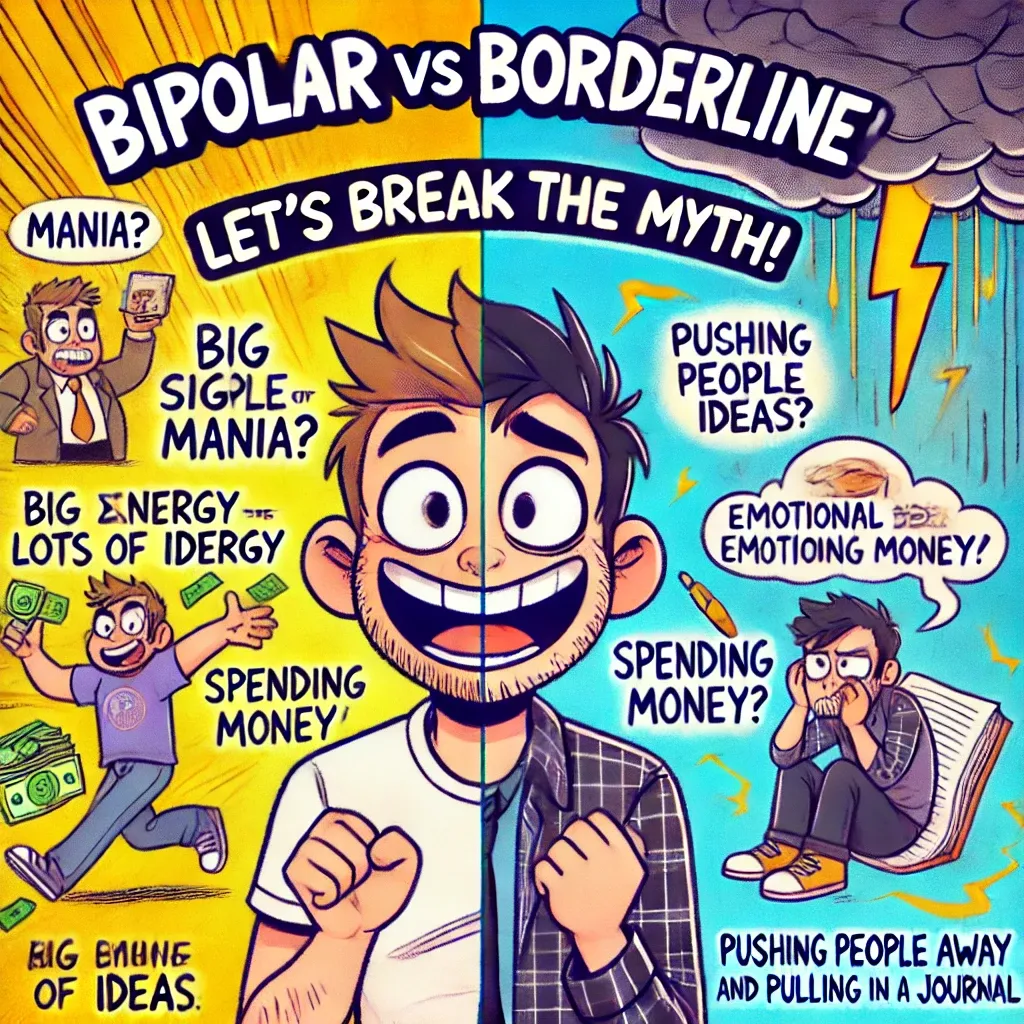Not Just Mood Swings: What Bipolar Disorder Really Is

🧠 Understanding Bipolar Disorder: Beyond the Myths
Good morning readers, today we are going to do something a bit different. I am going to show you two different scenarios, and I want you to pick which one you think applies to someone with bipolar disorder.
Scenario A:Maria feels like she’s on top of the world. She hasn’t slept in three days but feels full of energy. She’s started multiple ambitious projects, spent thousands of dollars on things she doesn’t need, and is talking rapidly—jumping from topic to topic. A week later, she can barely get out of bed and is overwhelmed by hopelessness.
Scenario B:Taylor often feels empty and fears being abandoned. Her relationships are intense and unstable—she idolizes someone one day, then believes they’ve betrayed her the next. Her emotions swing rapidly within hours, and she’s impulsively harmed herself during emotional distress.
Answer Key:
- Scenario A: Bipolar Disorder
- Scenario B: Borderline Personality Disorder
For some of you, you may have grown up similar to me thinking that bipolar disorder was typically describing someone with borderline personality disorder. However, they are very different! So today we are going to focus our discussion on this disease and identify what makes this so unique!

🧩 What Is Bipolar Disorder? (Expanded)
Bipolar disorder is a chronic psychiatric illness marked by intense and abnormal shifts in mood, energy, activity levels, and the ability to function day-to-day. These shifts go far beyond regular ups and downs—they can be extremely disruptive to work, relationships, and overall quality of life.
The hallmark of bipolar disorder is the presence of mood episodes:
- Manic episodes involve elevated or irritable mood, increased activity, decreased need for sleep, grandiosity, racing thoughts, impulsive behavior, and poor judgment. Some may even experience psychotic symptoms such as delusions or hallucinations.
- Depressive episodes include deep sadness, loss of interest in activities, fatigue, feelings of worthlessness or guilt, difficulty concentrating, and sometimes thoughts of death or suicide.
- Hypomanic episodes are similar to manic ones but are less severe and typically don’t involve psychosis or require hospitalization.
There are three major types of bipolar disorder, each with its own pattern:
- Bipolar I Disorder – Defined by at least one full manic episode, often followed by major depressive episodes. The mania in Bipolar I can be extreme and dangerous, sometimes requiring hospitalization.
- Bipolar II Disorder – Involves at least one hypomanic episode and one major depressive episode, but no full manic episode. People with Bipolar II may be misdiagnosed with depression if hypomania isn’t recognized.
- Cyclothymic Disorder (Cyclothymia) – A milder form involving chronic fluctuating moods with hypomanic and depressive symptoms for at least two years (one year in youth), without meeting full criteria for either mania or major depression.
Some individuals experience “mixed episodes”, where features of mania and depression occur at the same time—such as being full of energy but deeply hopeless. These can be especially risky and emotionally distressing.
People with bipolar disorder often experience periods of stability between episodes. However, without proper treatment, these cycles can become more frequent and severe over time.
It’s important to recognize that bipolar disorder is not a character flaw or weakness—it’s a neurological condition with biological roots, often requiring a combination of medication, therapy, and supportive routines to manage effectively.
(Sources: National Institute of Mental Health, American Psychiatric Association, Mayo Clinic)
🔬 Causes and Risk Factors
Bipolar disorder is biologically based, with a strong genetic component. Environmental stressors, trauma, and substance abuse can trigger episodes in genetically predisposed individuals. Neuroimaging has shown structural and functional brain differences in people with bipolar disorder—particularly in regions involved in emotional regulation.
(Source: Harvard Medical School, 2023)
💊 Diagnosis and Treatment
Diagnosis is often delayed due to confusion with other disorders (like borderline personality disorder, ADHD, or depression). It requires careful psychiatric evaluation over time. Treatment often includes:
- Mood stabilizers (e.g., lithium, valproate)
- Antipsychotics (especially for mania)
- Psychotherapy (especially CBT and family-focused therapy)
- Lifestyle regulation (sleep, stress management, and avoiding substances)
Early diagnosis and a personalized treatment plan dramatically improve quality of life.
(Source: Mayo Clinic, 2024)
🌍 Why This Matters
In a world where mental health awareness is growing, misunderstanding bipolar disorder can lead to stigma and mislabeling. Mistaking bipolar disorder for “moodiness” or confusing it with personality disorders may result in misdiagnosis and improper care. Educating ourselves and others about its true nature promotes compassion, early treatment, and advocacy.
🚀 Spotlight on Future Applications
Research is advancing in genetic biomarkers, digital mood-tracking apps, and even psychedelic-assisted therapy as potential aids in managing bipolar disorder. Personalized medicine, through better brain imaging and pharmacogenetics, may one day allow for more accurate, faster diagnoses and tailored treatments.
(Source: National Alliance on Mental Illness & Johns Hopkins Psychiatry, 2023)
🎯 Did You Know?
🧠 Reflection Questions
- Why do you think bipolar disorder is often confused with borderline personality disorder in pop culture?
- How might increased mental health literacy impact the way society treats individuals with bipolar disorder?
- What role could technology play in improving early diagnosis and ongoing care?
Want to know more? Here is a whole podcast series discussing the various aspects of Bipolar disorder!
👋 Personal Note:
The first time I saw someone with Bipolar disorder, I was convinced everything they were telling me was the truth. These individuals are so convincing with their stories; what they are trying to tell you is shocking. Just as interesting as their stories and internal thoughts are watching the treatment for these patients take place over the course of multiple days. The changes in their behavior even after one day into their treatment make you question if they are even the same person! It is incredible to see what proper medical treatment can do for these people and why it is so important to maintain lifelong treatment since one manic episode could change their lives forever.
📲 Follow us for more:
- Instagram: @thevarrockstreetjournal
- TikTok: @varrock.street.jo
📚 References
American Psychiatric Association. (2022). What is bipolar disorder? https://www.psychiatry.org/patients-families/bipolar-disorders/what-are-bipolar-disorders
Harvard Medical School. (2023, March). Bipolar disorder: A misunderstood illness. Harvard Health Publishing. https://www.health.harvard.edu/mind-and-mood/bipolar-disorder-a-misunderstood-illness
Mayo Clinic. (2024, January 5). Bipolar disorder. https://www.mayoclinic.org/diseases-conditions/bipolar-disorder/symptoms-causes/syc-20355955
National Alliance on Mental Illness. (2023). Bipolar disorder. https://www.nami.org/About-Mental-Illness/Mental-Health-Conditions/Bipolar-Disorder
National Institute of Mental Health. (2022, July). Bipolar disorder. U.S. Department of Health and Human Services. https://www.nimh.nih.gov/health/topics/bipolar-disorder
Johns Hopkins Medicine. (2023). Bipolar disorder research and innovation. https://www.hopkinsmedicine.org/psychiatry/specialty_areas/mood_disorders/bipolar.html
